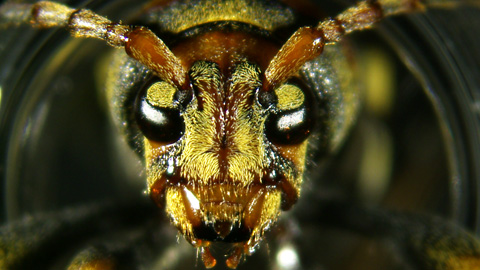New invasive Asian beetle pest in Catalonia kills mulberry trees

30/05/2018
A new species of invasive beetle from northeastern Asia has settled in Catalonia where it has been seen to severely infest and eventually kill mulberry trees in private and public grounds. The Institute of Science and Environmental Technology of the Universitat Autònoma de Barcelona (ICTA-UAB), in collaboration with the City Council of Barberà del Vallès, detected and has been studying since 2014 the presence of the longhorn Xylotrechus chinensis, a beetle of the family of cerambycidae, and warns of the important risk of it spreading widely across Europe.
This insect, which at first sight looks like a wasp, has been named in Spanish “Escarabajo-avispa taladro de las moreras” by ICTA-UAB researcher and first author of the study Víctor Sarto i Monteys. It comes from northeastern Asia (China, Korea, Japan and Taiwan), and reached Catalonia no later than 2012, probably inside wooden crates. Later it spread through the municipalities of Barberà del Vallès, Badia del Vallès, Cerdanyola del Vallès and Ripollet, occupying at present an area of 44 km2 and causing a devastating effect on the mulberry trees of the region. This is because the larvae of the insect feed on the phloem (living external part of tree trunks and branches), interrupting the flow of sap and therefore producing the death of the tree. In addition, when they are ready to pupate, the larvae drill the xylem (hard internal part of the tree), damaging its structure and favouring the fall of affected branches, with an important risk for citizen security. In these municipalities, the affectation of trees reaches 45%.
The study warns that according to previous studies carried out in Asia, the larvae of the longhorn beetle could also affect fruit trees such as apple trees, pear trees and grape vines, "which could be of great economic significance for the country's fruit and wine sector". The beetle has a quite large body measuring between 15-25 mm in length, while its antennae are relatively short for a cerambycidae, and are widely separated. Both its yellow and black print, as well as its body position and the buzz noise produced when threatened, makes them resemble a wasp. They hibernate as larvae in mulberry trees and emerge as adults in July. It is the larvae that feed on the wood, damaging the tree. "Although the affected trees show an apparently healthy aspect, their deterioration can be advanced with the risk of branches collapsing. This is an important risk since mulberry trees are often used to offer shade in public parks", Sarto I Monteys says.
The study A New Alien Invasive Longhorn Beetle, Xylotrechus chinensis (Cerambycidae), Is Infesting Mulberries in Catalonia (Spain), published this month in the scientific journal Insects, describes significant aspects of the life, seasonality and reproductive capacity of this insect after a thorough study of specimens in the laboratory and observation of affected trees. The study suggests possible control methods to prevent its spread. In addition to the felling of affected trees, which is taking place these days in the affected municipalities, Sarto i Monteys proposes the application of external products that hinder the oviposition of females on the bark of mulberry trees, and endotherapy, consisting of injecting a soluble solution of insecticide into the tree's xylem. The insecticide would thus be conducted to the phloem, from which the larvae feed, and would kill them.